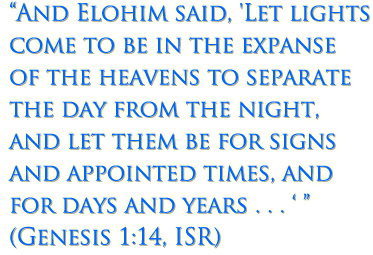What does the Bible say about the New Year?
(1) What does the Bible say or indicate about the New Year?
In Exodus 12, Yahuwah instructs Moses:
"This month shall be unto you the beginning of months: it shall be the first month of the year to you." (Exodus 12:2, KJV)
In context, we know that this was in or near spring1, but how was Moses to demarcate "the first month" in future years? How was he to know when spring began? Was he to base the New Year on vegetation (i.e. barley), or was he to look to the heavens? Genesis holds the answer:
"And Elohim said, 'Let lights come to be in the expanse of the heavens to separate the day from the night, and let them be for signs and appointed times, and for days and years, and let them be for lights in the expanse of the heavens to give light on the earth.' And it came to be so." (Genesis 1:14-15, ISR2)
Genesis 1:14 states in plain language that the heavenly bodies are to be for "signs and appointed times, and for days and years." There is no mention of vegetation in this passage. Nowhere in  Scripture is it stated that the beginning of the year is to be determined by examining barley. To suggest that the New Year hinges on the ripeness of the barley, when Scripture incontrovertibly declares that the heavenly bodies are to determine years, is to add to Yahuwah's Word.
Scripture is it stated that the beginning of the year is to be determined by examining barley. To suggest that the New Year hinges on the ripeness of the barley, when Scripture incontrovertibly declares that the heavenly bodies are to determine years, is to add to Yahuwah's Word.
You shall not add to the word that I command you nor take from it that you may keep the commandments of Yahuwah your Eloah that I command you. (See Deuteronomy 4:2.)
Whatever I command you, be careful to observe it; you shall not add to it nor take away from it. (See Deuteronomy 12:32.)
Every word of Eloah is pure: He is a shield unto them that put their trust in Him. Add thou not unto His words, lest He reprove thee, and thou be found a liar. (See Proverbs 30:5-6.)
While popular tradition teaches that the ripeness of Palestinian barley is the beacon for the New Year, this supposition cannot be supported by even one passage of Scripture. (For more on why the supposed "barely law" cannot rightfully be the determinant for the New Year, refer to the section below, entitled "Insurmountable Issues with Using the 'Barley Harvest Law of Moses.'")
Now that we have established with certainty that the heavenly bodies are to determine years, the question is "What is it that takes place in the heavens to let us know that Winter is over and a New Year can begin?" A very important clue can be found in Exodus 34.
"And thou shalt observe the feast of weeks, of the firstfruits of wheat harvest, and the feast of ingathering at the year's end [H8622]." (Exodus 34:22, KJV)
Now, let us examine the Hebrew word, translated here as "end."
H8622 (tekufah) - "coming round, circuit of time or space, a turning, circuit" (Brown-Driver-Briggs Hebrew Dictionary)
While it is not immediately apparent from the KJV, the word translated here as "end" [Strong's H8622] is referring to the fall equinox (also called the Autumnal equinox) in the middle of the year. This is confirmed by the fact that the Feast of Ingathering, also referred to as the "Feast of Tabernacles" and the "Feast of Booths," takes place in fall, in the Seventh Month (Leviticus 23:34) - in the middle of the year, not at the end of the year.
The Encyclopedia Judaica agrees with this interpretation.
"As stated, the four seasons in the Jewish year are called tekufot [plural of tekufah; H8622]. More accurately, it is the beginning of each of the four seasons – according to the common view, the mean beginning – that is named tekufah (literally "circuit," from קוף related to נקף , "to go round"), the tekufah of Nisan denoting the mean sun at the vernal equinoctial point, that of Tammuz denoting it at the summer solstitial point, that of Tishri, at the autumnal equinoctial point, and that of Tevet, at the winter solstitial point." (Encyclopedia Judaica, Article "Calendar", p.356)
The translations below offer a more accurate rendering of Exodus 34:22.
"And thou shalt keep to me the feast of weeks, the beginning of wheat-harvest; and the feast of ingathering in the middle of the year." (Exodus 34:22, Brenton's English Septuagint)
"And a feast of weeks thou dost observe for thyself; first-fruits of wheat-harvest; and the feast of in-gathering, at the revolution of the year." (Exodus 34:22, YLT)
"And thou shalt observe the feast of weeks, of the first-fruits of wheat-harvest, and the feast of ingathering at the turn of the year." (Exodus 34:22, Darby)
Thus far, we have established the following:
- The Feast of Ingathering revolves around the fall harvest in the Seventh Month (Leviticus 23:34).
- The Feast of Ingathering is associated with the fall equinox in the middle of the year.
It is only logical to conclude based on the above that the beginning of the year then is connected to the spring equinox, which takes place about six months before and after the fall equinox. If the fall feasts are connected to the fall equinox in the middle of the year, then the spring feasts must be connected to the spring equinox at the beginning of the year.
It is very important to note here that the Feast of Ingathering is directly associated with the fall equinox; therefore, in order to fulfill the Biblical mandate, the Feast of Ingathering must be held on or very near the fall equinox.
(1a) Is this in agreement with reckoning the New Year by the first New Moon after the vernal equinox?
No, not always. Sometimes, when using this method of reckoning, the Feast of Ingathering will be held on or very near the fall equinox. Sometimes, however, the Feast of Ingathering will fall up to 5 weeks after the fall equinox! (This would actually be the case in 2015, if this method were used.)
(1b) Is this in agreement with reckoning the New Year by the New Moon closest to the vernal equinox?
Yes, always. Using this method, the Feast of Ingathering will always fall on or near the fall equinox. The earliest the Feast will fall is about 7-10 days before the fall equinox. The latest the Feast will fall is about 3 weeks after the fall equinox. (This is actually a liberal estimation; we have not found a single case where the Feast would fall an entire 3 weeks after the equinox, when using this method.)
Conclusion:
The only definitive anchor point given in Scripture for identifying the proper method of reckoning the New Year is the fall equinox. Exodus 34:22 states that the Feast of Ingathering (in the seventh lunar month) is to be held at the tekufah, which in context is the fall equinox. It is not possible to consistently keep this mandate when always reckoning the New Year by the first New Moon after the vernal equinox. If we reckon the New Year by the New Moon nearest the vernal equinox, however, the Biblical mandate will be consistently met.
1 Exodus 9:31 records that the barley and the flax were nearing maturity when they were destroyed by the plague of hail. By this, we know that it was springtime, or nearing springtime.
2 There are approximately 180 days between the autumnal equinox and the vernal equinox. (http://community.novacaster.com/showarticle.pl?id=11110;n=4001)









